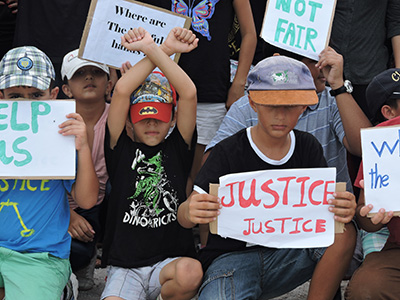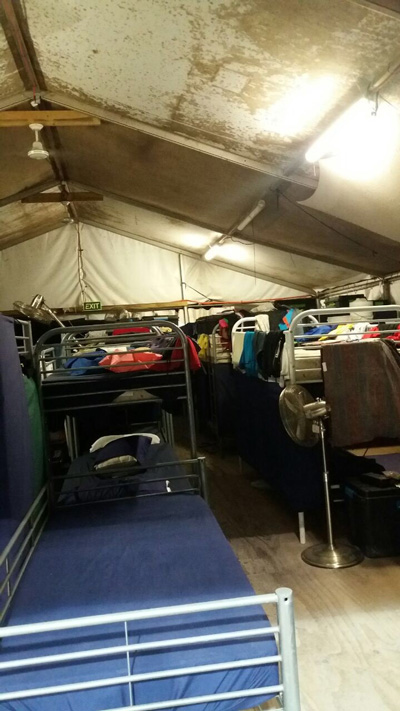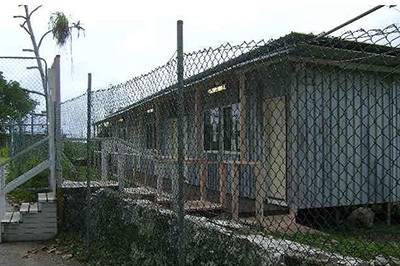From A World to Win News Service:
Australia: A War on Refugees
May 8, 2017 | Revolution Newspaper | revcom.us

Refugee children take part in a protest in March 2015 against their resettlement on Nauru and living conditions on the island. Photo: Amnesty International

According to Amnesty International, those transferred to Nauru initially spent a year or more housed in cramped vinyl tents in a detention facility called the “Regional Processing Centre” (RPC), with temperatures indoors regularly reaching 113 to 122 degrees Fahrenheit, and torrential rains and flooding. Photo: Amnesty International.

Newer housing at Nauru Detention center. Photo: UN
A World to Win News Service. May 8, 2017. “People here don’t have a real life. We are just surviving. We are dead souls in living bodies. We are just husks. We don’t have any hope or motivation.”
This is what a woman refugee told an Amnesty International researcher about life in Nauru. Seeking asylum in Australia, instead she was forcibly transferred to this tiny Pacific island and kept there. She wasn’t just making a poetic statement. She was speaking for the 21 year-old Somali woman Hodan Yasin who set herself on fire in May 2016, and the 23 year-old Iranian Omid Masoulmali, who also set himself on fire in Nauru and, in his case, ended his life. This is the message of the more than 60 refugees on this island who have either committed suicide or tried to harm themselves to escape an unbearable captivity. All this is the result of the extreme abuse, ill treatment and deliberate mental and psychological torture the Australian government has inflicted on refugees who try to reach Australia by boat.
Boats carrying thousands of refugees, mostly from Iran, Iraq, Afghanistan and South Asian countries, have headed for Australia for years. Some never made it. Many of the boats were old and in bad shape. If they capsized in the Indian Ocean between Indonesia and Australia, no one came to their aid. Many lives were lost because of the indifference of the Australian authorities. SOS calls went unanswered. Surviving witnesses recounted occasions when the coastguard was contacted and promised to send help, but no help ever came. It became increasingly obvious that the coastguard’s indifference constituted deliberate negligence. Proposed new laws were so brutal that many people could not believe they would be passed, let alone implemented. Yet they were approved in parliament by both mainstream parties and enforced by the coalition government that came to power in 2013.
“Operation Sovereign Borders” put the military in control of asylum operations. They intercepted boats at sea and took their passengers to one of two remote islands in the Pacific Ocean, Nauru and Manus (part of Papua-New Guinea), two nations dominated by Australia. Supposedly the refugees’ forced stay there was temporary while their application for asylum was processed. But months lengthened to years, and during these years the anti-immigrant laws got even tougher.
Following the passing of another anti-immigrant law in 2014, military vessels now patrolling Australian waters seize and capture migrant boats, towing them back to Indonesia or sending them back in inflatable boats or lifeboats. This cut off the flow of asylum seekers to Nauru and Manus, but those trapped there have little prospect of leaving. Now even if these asylum seekers are found to be refugees, they are told they will never be allowed to enter Australia. Instead, they must settle in Nauru and Papua New Guinea, or be taken to Cambodia. No matter where they may acquire citizenship, they are prohibited from ever setting foot in Australia in the future, even on tourist or business visas.
The “Life” of Refugees in Such Conditions
Currently, there are about 1,900 people being held on Australia’s two offshore detention islands. The latest Australian government statistics show there are 871 men in detention on Manus Island and 373 people living in the regional processing centre on Nauru. About 700 more refugees sent to Nauru live in the community on that island. (Guardian, February 2, 2017) Those settled in Papua-New Guinea and Cambodia may not be included in these figures.
Those transferred to Nauru initially spent a year or more housed in cramped vinyl tents in a detention facility where indoor temperatures regularly reach 45 to 50 degrees Celsius. Nauru has an area of 21 square kilometres, with extremely limited faculties for its barely 10,000 inhabitants.
The refugees taken there with life-threatening conditions, such as heart and kidney diseases, diabetes accompanied by weight loss and so on, do not receive specialised medical attention, according to the August 2, 2016 Amnesty International report. The fact that the Australian government treats refugees like criminals leaves them vulnerable to physical attacks and abusive treatment by some local residents outside the camps and sometimes inside as well. During one assault on a camp, an Iranian asylum seeker was killed and at least 70 were hurt. Women are especially endangered. They rarely ever leave the camps, and when they do, it is usually in a group or with male companions.
Ali Bagheri, a young refugee from Afghanistan of the Hazara minority there, arrived in Australia in 2001 after surviving a fire that killed his nephew on the boat that brought them. After that, he spent 10 years in detention in the South Pacific. He told BBC, “You don’t want anyone else to go through that… the people there had no hope. They had a lot of mental illnesses and psychotic disorders. Why keep innocent refugees and torture them? Every human being has the right to seek asylum…. As a little kid I had to witness people trying to commit suicide. I lost my childhood in that detention centre.” (BBC.co.uk, November 11, 2014)
This has been confirmed by the Amnesty International report that states refugees suffer from severe anxiety, inability to sleep, mood swings, prolonged depression, and short-term memory loss. This has affected children who suffer from nightmares and other worrying behaviour. They talk about the extreme pressure and prolonged uncertainty about their future in a way that clearly implies they are tormented by thoughts of self-harm or committing suicide.
The photojournalist Ashley Gilbertson, originally from Australia, managed to interview some of the people in Manus Island away from the eyes of the authorities: “[O]ver 900 of them, from Iran, Iraq, Sudan and elsewhere, have been detained since 2013. I’ve never come across refugees this broken. The vast majority didn’t want to share their stories with me. ‘What’s the point’, they would say. They have been beaten into despair, tortured by disempowerment…[Many] have taken up drinking, or trading cigarettes (they receive up to three packets per week) for local marijuana. Many take sleeping pills handed out by nurses. Anything to pass the time and escape from their anguish.” (“I Am Ashamed to Be Australian,” New York Times, December 12, 2016)
Refugees and Their Choices
Here again the usual question poses itself: Why do people choose to undertake such dangers and hardships? The reactionaries ruling the imperialist-developed countries have a stereotypical answer. They believe, or at least propagate, that the refugees come to these countries to abuse the welfare system and take advantage of their way of life. Refugees are called undesirable people, a burden on “taxpayers”, and blamed for unemployment, crime and other social problems. But the media rarely mentions that the vast majority of people who become refugees have no better choice.
Imperialist policies and intervention have given rise to the destructive wars in, to name only a few examples, Iraq, Afghanistan, Libya, Syria and Yemen, taking the lives of hundreds of thousands of people and causing the displacement of tens of millions. Many refugees are fleeing persecution by governments propped up by the very countries where they have to seek asylum. This violence goes hand in hand with the unequal relations through which the global system of trade and investment has enriched the imperialist powers and distorted the economy of many countries in Africa, Asia and Latin America, destroying the livelihood of millions of peasants and other people. Yet for the imperialist rulers, the problem is not the billions of afflicted people, but the very small percentage who seek refuge in the better-off countries.
The Australian government claims that its forcible transfer of refugees to Pacific islands is a policy of “deterrence” meant to ensure that other refugees will no longer risk death by taking a boat to Australia. In reality, this policy is a crime against people whose lives have been destroyed by the world imperialist system that Australia is a part of, and often, wars that Australia in particular has played a role in (such as Afghanistan). This policy is part of the normalisation of extreme cruelty against refugees on a world scale.
The previously mentioned photojournalist Gilbertson, who has covered refugee camps and the treatment of refugees around the world for 20 years, says that even after “seeing so many extreme atrocities” and “so much injustice against the refugees”, “in all that time, I have not seen the level of cruelty toward these vulnerable people that the Australian government is perpetrating against the refugees on Manus Island.” Yet in the UK, ministers have raised the possible adoption of the Australian method more than once. Prime Minister Theresa May has all but explicitly called for letting refugees drown in the Mediterranean to deter others from coming to Europe. To a lethal extent the European Union has moved closer and closer to the Australian model, which could be considered a kind of pilot project for other imperialist countries.
Recently the German Interior Minister Thomas de Maizière suggested that the refugees caught crossing the Mediterranean be transferred to centres in North African countries. Specifically, he had in mind the area in Libya under the control of a government imposed by Europe and the U.S. after Nato reduced the country to a hellhole. There have been recent reports of thousands of children and young women sexually and physically abused in the refugee centres in that part of Libya. The U.S. government, under Obama and now Trump, has supported Australia’s refugee policy, despite a recent dispute about whether or not the U.S. will now honour Obama’s commitment to take in a tiny number of Australia’s Pacific island detainees as a sign of solidarity with Australian policies.
Yet at the same time that the government of Malcolm Turnbull blusters that Australia will never change its polices, it is going to great lengths to hide their effects from the public at home and internationally. According to the Amnesty International report, “Australia and Nauru impose strict secrecy on the processing of asylum seekers on Nauru and refuse most requests to visit from journalists or researchers.... journalists in particular face severe restrictions on entry, with an $8,000 non-refundable visa fee and a protracted application process. Nauru has granted visas to just two media outlets since January 2014. Other requests have been rebuffed or met with no response. UN officials have been denied entry or in some cases have concluded that a visit would be impractical due to severe limitations on their access.” Other governments, in the first place the U.S., are complicit in this cover-up.
However, there has been strong opposition to this crime by many groups and individuals inside and outside Australia. Thousands of people have marched in Australia’s cities carrying banners saying, “Bring them here.” Among the refugees there are some who have not lost all hope and given up their just fight. There have been many occasions of resistance. In Manus in January 2015, hundreds went on hunger strike and barricaded themselves into a compound in the camp to disrupt the policy of keeping those granted refugee status on the island.
The refugee crisis is a crisis of the world capitalist-imperialist system. In “protecting” their borders with ever more violence, the imperialists are seeking to protect their system from upheavals resulting from the consequences of their system and all that they do to both profit from and maintain the lopsided division of the world. More exposure and much stronger opposition is needed to defeat these vicious attacks against refugees by taking the side of the oppressed and exploited against the oppressors and exploiters on a world scale.
On March 17, 2017, A World to Win News Service (AWTWNS) announced its transformation into a more thorough-going tool for revolution based on Bob Avakian’s new synthesis of communism. Read its “Editorial: Introducing a transformed AWTWNS” here.
Volunteers Needed... for revcom.us and Revolution
If you like this article, subscribe, donate to and sustain Revolution newspaper.
